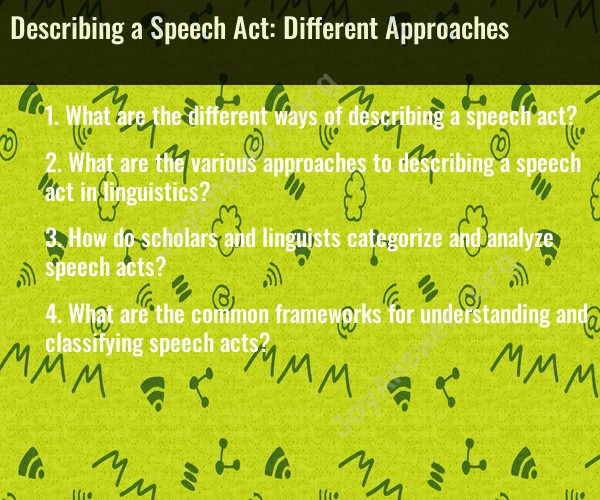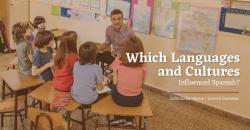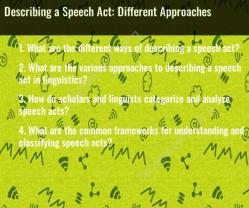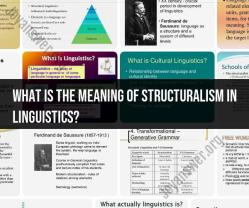What are the different ways of describing a speech act?
Speech acts are communicative actions or utterances that people perform when they speak or write. There are different ways to describe speech acts, each providing a unique perspective on the analysis of language and communication. Here are some of the different approaches to describing speech acts:
Austin's Speech Act Theory: John Searle, building on the work of J.L. Austin, proposed a classification of speech acts based on three categories:
- Locutionary Act: The act of producing sounds, words, or phrases.
- Illocutionary Act: The speaker's intended meaning or the communicative force of the utterance, such as asserting, requesting, promising, or suggesting.
- Perlocutionary Act: The effect or impact the utterance has on the listener, including their interpretation and response.
Grice's Theory of Implicature: Philosopher H.P. Grice introduced the idea of implicature, which deals with implied meanings or inferences that go beyond the literal meaning of words. This approach focuses on how speakers convey meaning indirectly and how listeners interpret implied messages.
Speech Act Theory of J.L. Austin: J.L. Austin's theory emphasizes the performative nature of language. He categorized speech acts into locutionary acts (the act of saying something), illocutionary acts (the intended communicative act), and perlocutionary acts (the effect on the listener).
Searle's Classification of Speech Acts: John Searle expanded on Austin's work and categorized speech acts into five main illocutionary points:
- Assertives: Statements or claims (e.g., stating, informing).
- Directives: Requests or commands (e.g., asking, ordering).
- Commissives: Commitments or promises (e.g., pledging, vowing).
- Expressives: Emotional or psychological states (e.g., apologizing, congratulating).
- Declarations: Acts that bring about changes in the external world (e.g., resigning, christening).
Performativity Theory: This approach, influenced by Austin's work, focuses on the idea that certain speech acts not only convey meaning but also perform actions. For example, saying "I now pronounce you husband and wife" in a wedding ceremony not only conveys information but also brings about a change in marital status.
Pragmatics and Conversational Analysis: Researchers in pragmatics and conversation analysis study speech acts in the context of everyday conversation. They examine how people use language to achieve their communicative goals, considering turn-taking, politeness strategies, and context.
Politeness Theory: This approach, often associated with Penelope Brown and Stephen Levinson, focuses on the strategies people use to manage face (social identity) during communication. Speech acts are analyzed in terms of politeness and face-threatening actions.
Contextual Pragmatics: This approach emphasizes the importance of context in understanding speech acts. It considers how context, including shared knowledge, social roles, and cultural norms, influences the interpretation of utterances.
Cognitive Pragmatics: This approach explores the cognitive processes involved in understanding speech acts. It considers how listeners infer meaning and intentions based on linguistic and contextual cues.
Sociolinguistics: Speech acts are examined in the context of social factors, such as gender, power dynamics, and social identity. Researchers analyze how social variables influence the way people perform and interpret speech acts.
Each of these approaches offers a different lens through which to analyze speech acts and their role in communication. The choice of approach may depend on the specific research or analytical goals, as well as the context in which the speech act occurs.
What are the various approaches to describing a speech act in linguistics?
Speech acts are a fundamental unit of analysis in linguistics. They are defined as utterances that perform an action in addition to conveying information. For example, the utterance "I promise to be there" is not only a statement about the speaker's future intentions, but it also performs the action of making a promise.
There are a number of different approaches to describing speech acts in linguistics. One common approach is to classify speech acts based on their illocutionary force. The illocutionary force of an utterance is the action that the speaker is performing by saying it. For example, the illocutionary force of the utterance "I promise to be there" is to make a promise.
Another common approach to describing speech acts is to classify them based on their perlocutionary effects. The perlocutionary effects of an utterance are the consequences that the speaker intends to bring about by saying it. For example, the perlocutionary effect of the utterance "I promise to be there" is to reassure the listener that the speaker will be present.
How do scholars and linguists categorize and analyze speech acts?
Scholars and linguists categorize and analyze speech acts in a number of different ways. One common approach is to use a speech act taxonomy. A speech act taxonomy is a system for classifying speech acts based on their illocutionary force and/or perlocutionary effects. For example, the following is a simple speech act taxonomy:
- Assertives: Assertives are speech acts that are used to state facts or opinions. For example, the utterance "The sky is blue" is an assertive.
- Directives: Directives are speech acts that are used to get someone to do something. For example, the utterance "Please close the door" is a directive.
- Commissives: Commissives are speech acts that are used to commit the speaker to doing something in the future. For example, the utterance "I promise to call you tomorrow" is a commissive.
- Expressives: Expressives are speech acts that are used to express the speaker's emotions or feelings. For example, the utterance "I'm so happy to see you!" is an expressive.
Another common approach to analyzing speech acts is to use conversational analysis. Conversational analysis is a method for studying the structure and organization of conversation. Conversational analysts are interested in how speakers use speech acts to achieve their communicative goals.
What are the common frameworks for understanding and classifying speech acts?
There are a number of common frameworks for understanding and classifying speech acts. Two of the most common frameworks are:
- John Searle's speech act theory: Searle's theory is based on the idea that speech acts consist of three parts: the locutionary act, the illocutionary act, and the perlocutionary act. The locutionary act is the act of saying something, the illocutionary act is the action that is performed by saying it, and the perlocutionary act is the consequence that the speaker intends to bring about by saying it.
- J. L. Austin's performative utterance theory: Austin's theory is based on the idea that some utterances are performative, meaning that they perform an action by being said. For example, the utterance "I promise to be there" performs the action of making a promise.
Both of these frameworks have been influential in the study of speech acts. They have helped scholars and linguists to understand the different ways in which speech acts can be used to communicate and to achieve communicative goals.
In addition to the frameworks mentioned above, there are a number of other approaches to understanding and classifying speech acts. For example, some scholars have focused on the role of speech acts in social interaction, while others have focused on the relationship between speech acts and language evolution.
The study of speech acts is a complex and interdisciplinary field. Scholars and linguists from a variety of backgrounds have contributed to our understanding of this important aspect of human communication.









